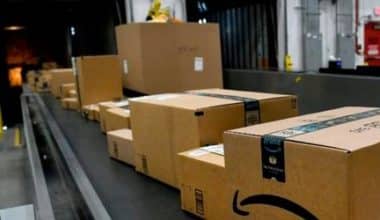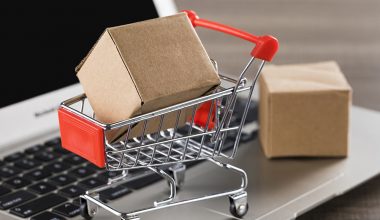Third-party logistics (3PL) companies, also known as fulfillment service providers, use several fulfillment centers to assist eCommerce retailers with order processing or fulfillment for online orders. But what exactly is a fulfillment center? How does it work? Does it offer a proven methodology that will help your business be efficient and improve the client journey? What advantages will it provide you, and will it save you money? You’ll learn that here.
What is a Fulfillment Center?
A fulfillment center is a physical location where activities are set up to routinely accept inventory and package deliveries and deliver customer orders on schedule and in good condition. A fulfillment center, also known as a distribution center (DC), is a building where merchants and other similar businesses hold their merchandise until it is distributed to the client.
Unlike a warehouse, a fulfillment center is often maintained by a third-party logistics provider (3PL) that provides inventory storage and a number of other operational activities, including freight transportation, handling cross-docking, customer service, and most significantly, order fulfillment. When deciding between a fulfillment center and a warehouse, a fulfillment center has significantly more features to assist e-commerce businesses to prosper.
What Are the Functions of Fulfillment Centers?
Fulfillment centers typically cater to B2C brands. Items are kept, chosen, packed, and dispatched directly from a fulfillment center to a customer’s door. Picking, packing, and shipping entire orders, as well as managing accounting, sales, and other operational duties, can quickly consume more hours than there are in a day.
When their e-commerce business grows, B2C brands frequently engage the assistance of a fulfillment center. A fulfillment provider manages all fulfillment tasks in one location, allowing firms to focus on sales, customer service, and company growth. Services provided by a fulfillment center include:
- Real-time inventory management
- Selecting, assembling, and packaging
- Order processing and fulfillment
- Coordination of transportation
#1. Real-Time Inventory Management
When a brand puts an order with a manufacturer, the inventory is sent to the brand’s order fulfillment center to be sorted and stored. The idea is to keep a regular cycle of sales and inventory replenishment continuing in order to keep products from going bad on the storage shelves. This is accomplished by real-time inventory management and tracking, as well as predictive analysis throughout the seasonal ebbs and flows. This type of data enables merchants to make operational decisions that reduce supply chain costs and efforts.
#2. Selecting, Kitting, and Packing
Once a seller gets an order from a customer, personnel working at a fulfillment center will pick up and package the items within the order. Several providers will offer kitting as an added service to increase efficiency throughout the order fulfillment process. Kitting is the process of grouping and packaging many things into a single unit. Businesses can increase efficiencies while lowering overall shipping costs by taking individual items and bundling them as a kit. A good example of kitting is beauty subscription boxes that bundle related products from different manufacturers into a single package to sell on a monthly, quarterly, or annual basis.
#3. Fulfillment of Orders
The role of a fulfillment center is to fulfill orders as rapidly as feasible and then dispatch them to the ultimate client. Fulfillment centers are often fast-paced locations where staff process, package, and ship orders directly to customers.
Fulfillment centers typically integrate advanced technology to manage and enhance workflows, from receiving and processing orders through inventory management and carrier pickup, in order to handle the continuous inbound and outbound transportation of products. Flowspace provides e-commerce fulfillment services and software that integrates with businesses’ online storefronts and sales platforms. Orders, inventory, and customer insights are all accessible through the Flowspace program. It enables organizations to carefully plan for inventory replenishments, predict sales patterns, and keep the fulfillment process operating as smoothly as possible.
#4. Coordination of Transportation
Fulfillment centers ship the product(s) to the customer or end-user after choosing and packing an order. Order tracking is available from the moment the package leaves the fulfillment center to ensure full visibility for both the customer anticipating the package and the e-commerce business selling the product.
What is a Fulfillment Warehouse?
A fulfillment warehouse is commonly interchanged with the word “fulfillment center”. A stand-alone warehouse differs substantially from this. A fulfillment warehouse performs numerous more functions in addition to inventory storage.
The average shipping warehouse in the United States is greater than 25,000 square feet. Around 35% of warehouses are smaller than the average shipping warehouse, whereas over 50% of current warehouses are 50,001 square feet or larger.
What Distinguishes Fulfillment Centers from Warehousing?
Let’s take a look at some of the details of these two warehouses.
Long-term vs. short-term storage
While a 3PL’s fulfillment center includes warehousing — holding a merchant’s inventory in designated locations — the main purpose of a fulfillment center is to turn goods over rapidly.
The merchant may be forced to pay exorbitant warehousing fees if the product is left at a fulfillment center for more than a month. But, sellers should deliberately send extra inventory to their fulfillment centers to ensure that there is always adequate stock on hand prior to shipment.
The role of a fulfillment center is to efficiently meet customer shipping expectations, whereas the role of a warehouse or on-demand storage solution is to store products. This is made possible when retailers keep products in fulfillment centers located near their customers, to reduce shipping costs, time in transit, and delivery zones.
Operations Unlike static or inactive warehouses, a fulfillment center is always moving and has a far more complex operation. In a fulfillment center, a 3PL offers a range of order fulfillment services, including:
- Receiving Inventory
- Making pick lists and selecting things
- Assembling and kitting goods
- Boxes for packing
- Shipping labels
- Orders for delivery
- Managing returns
As far as what’s going operationally in a warehouse, the main action occurs when inventory is added or transferred out. There aren’t many other services available.
Amazon warehouses and Amazon fulfillment centers operate on a similar level, treating them more as sortation centers and delivery stations. Packages move on the conveyor belt as staff sift small and large purchases and prepare them for shipping with Amazon Delivery or a third-party firm such as USPS.
Frequency of Freight Carrier Pickups
A fulfillment company can work with a variety of shipping carriers. Shipping carriers must pick up packages at least every day67` since a fulfillment center runs to fulfill direct-to-consumer orders as soon as they are placed. This assures items will be delivered to clients in time as promised.
Shipping carriers may need to pick up client orders for any guaranteed same-day or next-day shipping options chosen by customers at specified times each day, depending on the exact services a fulfillment firm offers. Other carriers and services will have regularly scheduled pickups, for both domestic and international cargo.
Retail fulfillment businesses will have cutoff times for placing orders. For example, customer orders placed before noon local time will be processed at the fulfillment center and shipped on the same day.
A warehouse, on the other hand, will often require scheduled, less frequent collections because it is more cost-effective to ship freight and have boxes packed together on a pallet rather than printing individual shipping labels.
Freight providers strive to aggregate merchandise from various pickup sites for PTL and LTL freight shipments, which might cause a delay in pickup/delivery time, therefore merchants should allow for a longer turnaround time from prep to pick up.
The Benefits of Using a Fulfillment Center
What are the primary benefits of using fulfillment providers for online sellers?
#1. Get rid of inventory and packaging crates.
Unless you’re a brick-and-mortar business, managing a physical place may not be optimal. It’s no wonder that many e-commerce businesses choose to avoid the hassles of inventory storage and e-commerce warehouse.
A fulfillment center is also a good option if you don’t want to pack boxes and run to the post office every day. The inability to keep up with your growing order volume is the number one indicator that it’s time to hire a fulfillment center. Fulfillment services, whether they specialize in wholesale fulfillment or retail fulfillment, allow you to spend less time thinking about packing supplies and post office lines and more time growing your business.
#2. Concentrate on the broad picture
While packing boxes and delivering client orders are essential to achieving customer expectations, they are typically tasks that may be readily outsourced. Entrepreneurs and eCommerce store managers have an unending to-do list, so they must stay laser-focused on the things that only they can complete and those that will help them scale and make money.
Removing the time spent on order fulfillment and instead focusing on marketing, customer support, and product management can help eCommerce organizations be more strategic and less operational. There will never be enough time in the day, but employing a professional fulfillment center can help sellers be more aggressive in other parts of the business.
#3. Leave it to the professionals.
Inbound and outbound logistics can be hard, and a fulfillment center is a sophisticated machine with many moving elements that must concurrently function together. From order processing and inventory management to preparations for busy shopping seasons, fulfillment businesses are domain specialists and have seen it all.
A single fulfillment center manages operations for a large number of e-commerce enterprises and ships millions of orders on a daily basis. Due to this, their volume and experience make them a strategic partner.
Fulfillment companies may also achieve higher efficiencies in everything from the cheap shipping rates they negotiate with carriers to the number, size, and location of their fulfillment centers — all of which can be used by the e-commerce businesses they work with.
#4. Automate the warehouse and fulfillment processes.
The center of modern fulfillment services is technology. This means that every stage of the fulfillment process is automatically documented in real-time, allowing e-commerce firms to know the status of their inventory and each order in the fulfillment center without having to be there.
This is conceivable when fulfillment systems have built-in interfaces with e-commerce platforms and marketplaces. This connection allows each customer order to be automatically sent to the fulfillment center for picking, packing, and shipping. After an order is dispatched, tracking information is sent back to the e-commerce site and shared with the customer.
Fulfillment Centers’ Disadvantages:
Fulfillment centers have some disadvantages.
#1. Cost
Sellers must pay providers for their services, such as a set cost to link your store with the fulfillment center, as well as fees for each order handled.
#2. Lack of control
Businesses have little influence over how quickly a fulfillment center processes orders and cannot intervene in fulfillment operations when anything goes wrong. This may lead to customer relations challenges, which can result in unfavorable feedback and non-returning customers.
#3. Shipping Time
Although the fulfillment firm may be able to process orders more quickly, the time it takes to transport an item from a center to the consumer is heavily dependent on where the center is located, potentially lengthening shipment timelines. These factors need to be considered before picking a mate.
#4. Lack of customization
Often, centers do not permit sellers to customize orders or add extra touches, such as sending a personalized thank-you card for each buyer.
#5. Delays in inventory replenishing
Most centers require the vendor to maintain track of inventory and replenish it as needed. This means that orders may be delayed if a seller is unable to immediately replace out-of-stock goods.
How to Decide Between a Fulfillment Center and a Warehouse
Making the appropriate decision about whether you can rely on your own warehouse or whether you need to hire fulfillment services from a 3PL provider is critical. This decision will be influenced by a number of factors, including:
#1. Demand
Where are your products most in demand? If there is a high degree of worldwide demand, warehousing in collaboration with a global shipping agency may be the ideal solution. For local, regional, and national demand, a fulfillment and distribution center will more likely offer you the finest answer.
#2. Human resources
If your orders are fulfilled at a fulfillment center, you don’t require a dedicated warehouse workforce. That means you save on salaries, benefits, and other related costs. You do not, however, have influence over who hires or manages the people who fill your orders.
#3. Inventory turnover and space
Certain goods may move more quickly than others. In-demand commodities may necessitate warehouse storage and a large amount of square footage. As a result, your physical location may not have enough space. You may even choose a warehouse and a fulfillment center in some circumstances.
#4. Flexibility
Consumers increasingly anticipate more flexible delivery alternatives such as BOPIS (purchase online, pick up in-store) or more varied shipping providers. Ask yourself: are you able to handle flexible fulfillment in-house? If not, it is preferable to choose a good fulfillment center.
Choosing between storing and using a fulfillment center might be particularly tricky in this era of multichannel retailing. For a firm to own (or rent) its own warehouse represents a substantial expenditure. It should only really be explored if you are confident it is cost-effective and meets your needs and model.
How Much Does a Fulfillment Center Cost?
There is no standard flat rate for fulfillment centers, and the fees you may face will depend on a variety of criteria. But, to provide an estimate, some of the potential costs are mentioned below:
| Service | Pricing type | Cost |
| Receiving goods | Flat rate | $25 for the first 2 hours |
| Storage | Per storage receptacle | Per month: Pallet, $40. Shelf, $10 |
| Picking & Packing | Included in final costs | Around $0.20 per pick |
| Packaging (standard) | Included in final costs | Free (for specialist or customized packaging, rates will vary) |
| Kitting fees | Per project | Starts at around $0.40 per kit |
| Shipping delivery | Normally passed directly to the client | Will vary depending on multiple factors: weight, size, destination, route, same-day shipping, etc. |
Should I Utilize a Fulfillment Company?
This is a decision you must make based on the variables outlined in our previous section, “How to Choose Between a Fulfillment Center and Warehouse.” Warehousing can be expensive, and its use is dependent on your degree of demand as well as the geographical regions from which that demand derives.
Nonetheless, in today’s e-commerce market, fulfillment centers tend to match well with client desires. They provide a sophisticated ordering process, and because they have good partnerships with carriers, they can transport orders promptly and effectively.
How Much Space Do I Require?
As with costs, there is no precise solution. Yet, deciding on space will be heavily influenced by your ongoing demand as well as your demand predictions. If, for example, you know you have seasonal peaks, you will want to use more space in the run-up to those peaks to guarantee demand is satisfied.
But, you do not want things sitting in an e-commerce fulfillment warehouse for extended periods of time. The primary principle of hiring a fulfillment service is to have a quick turnaround without running out of stock. Plan ahead at least a year; consider your year’s calm and busy seasons and work around them.
Conclusion
Inventory management that is both efficient and cost-effective is crucial for any e-commerce business. Whilst the terms “warehouse” and “fulfillment center” are sometimes used interchangeably, the demand for basic warehouse space to hold inventory differs from the need for full fulfillment logistics services.
Such distinctions are due to the type of firm you work for: A warehousing firm that can help keep huge volumes of merchandise over a long period of time, or a fulfillment company that can promptly ship orders out to your customers from their fulfillment center(s).
- AMAZON AUTOMATION: Overview, Scam, Investments, Store
- CUSTOMER CALL SERVICE: Duty, Quality, Types, and What to Know
- ORDER FULFILLMENT: Meaning and Top Software Solutions
- Top 25 Warehouse Management Systems Software In 2023
- 21 Best CALL CENTER PHONE SYSTEMS & Reviews in 2023 (Updated).






